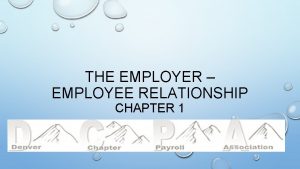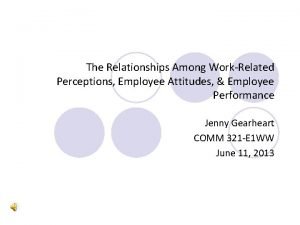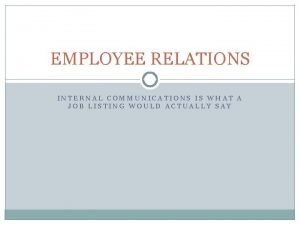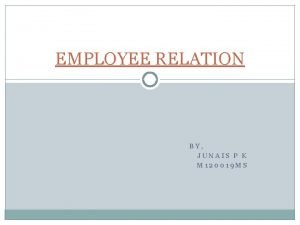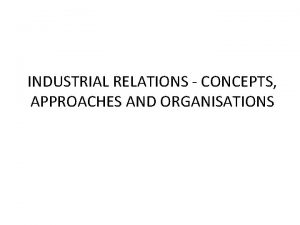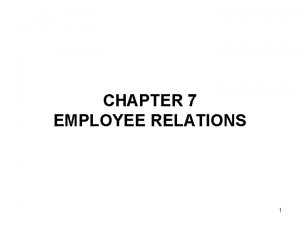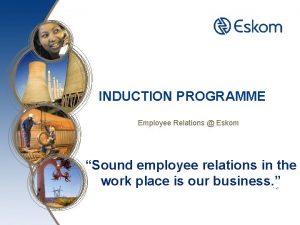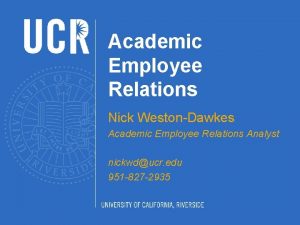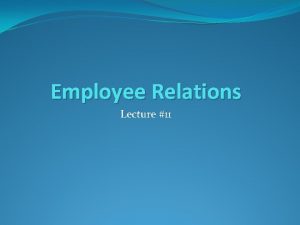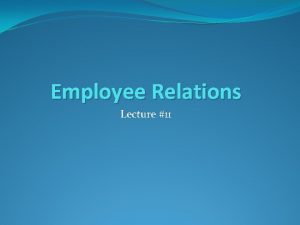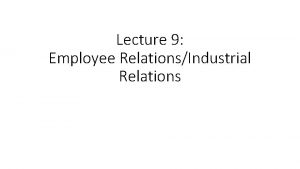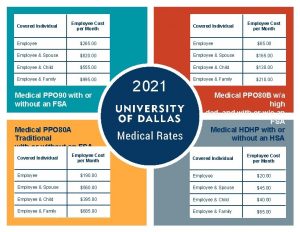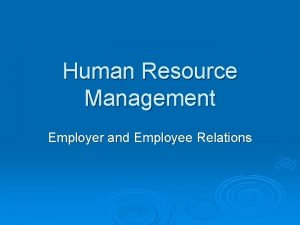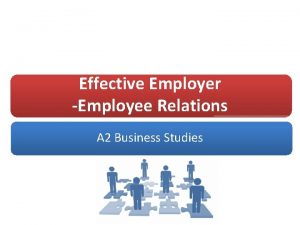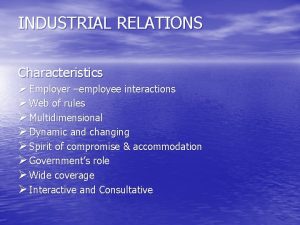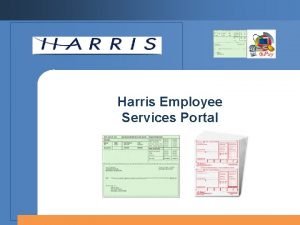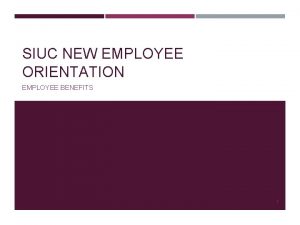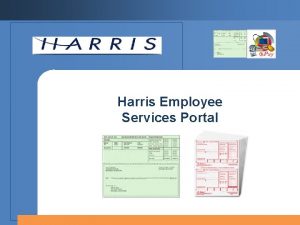Employer Employee Relations Content Employee Employer relations Different























- Slides: 23

Employer / Employee Relations

Content • • Employee / Employer relations Different approaches to employee relations: Collective bargaining Individual bargaining Employee participation and industrial democracy Role of trade unions and ACAS Principals of employment law

What is Employee Relations? • Employee and Employer Relations describes the relationship between workers and employers in business

Why is it important? • Motivation • Reputation : Potential customers, investor and staff • Output • Efficiency • Profit levels

Collective v Individual Bargaining • In the nineteenth century workers used to negotiate their own pay and conditions with their employers- INDIVIDUAL BARGAINIG • Collective bargaining occurs when workers allow the union to negotiate on their behalf. Negotiations can be with an individual employer or an employers' association.

Different Approaches To Employee Relations • The workforce is becoming increasingly flexible with an increased emphasis on part-time and temporary workers and against full-time permanent workers • A flexible work force is cheaper for firms, allows them to meet changes in demand, reduces training and allows for specialisation • However there is less security, communication may be problematic and

Salaries Vs Wages • Full time salaried workers tend to have more “rights” and job security than part time temporary workers

Employee participation and Industrial democracy • Employee participation – workers being involved in business decision making • Industrial democracy – the methods which workers can influence business decisions

Works councils • These are forums where workers and management meet to discuss issues concerning work e. g. working conditions, pay, training • Usually members are elected • Often used where there are no trade unions

Employee shareholders • Where workers can gain shares in the company • There are tax benefits • Idea is by owning shares performance and motivation of the workforce increase

Autonomous work groups • This is where teams of workers have a high degree of control • Authority has been delegated from senior management • Basis of groups is that motivation and productivity should be increased

Team working • Teams are responsible for a specific part of the production process • This can help increase motivation • Team working is compatible with democratic leadership

Quality Circles • This is when groups of workers meet to talk about ways to improve quality of products • Usually a group of 3 -10 workers who meet for 1 -2 hours 2 -3 times a month • These often provide imaginative solutions to business problems

The Role of Trade Unions 1. 2. 3. 4. Craft unions : represent skilled workers from one occupation General unions representing mainly unskilled workers from many occupations e. g. TGWU (Transport and General Workers' Union). Industrial unions representing mainly workers in one industry. E. g. NUM (miners' union) Professional or white-collar unions representing skilled workers in mainly service industries. E. g. NUT (teachers' union).

The Aims of Trade Unions • Improve the pay of workers. • Improve working conditions and secure longer holidays. • Protect members' jobs. • Provide local, social and welfare facilities. • Influence government policy

The Trades Union Congress • Made up of over 90 unions representing more than 9 million members • An annual conference decides overall union policy and elects the General Council • The General Secretary of the TUC is the trades union spokesman in any negotiations with the government or employers' organisations.

Disputes & Restrictive Practices • Disputes can arise over pay, working conditions, redundancies etc • Restrictive Practices may then follow such as: • A closed shop - union insists all workers are T. U members. • Demarcation when a union insists that only their members do certain jobs

Industrial Action • • • If negotiations break down Unions can: Work to rule : do the bare minimum Impose an overtime ban Strike and refuse to work altogether Picketing: ask other members not to enter ‘Blacking’: Refusing to deal with certain employees or suppliers because they have refused to participate in I. A • Employers can operate a lockout and refuse workers entry or they can dismiss striking workers for breach of contract

ACAS • Arbitration is when employers agree to an independent referee to try to find common ground • Advisory Conciliation and Arbitration Service (ACAS) has been available to help solve disputes • In the 1980 s and 1990 s there have been an increasing number of single-union agreements where employers negotiate with only one union

Employment Law – Individual labour law • Looks at the rights and responsibilities of individuals: – Equal Pay Act 1970 – both sexes treated equally re: pay – Sex Discrimination Act, 1974 – cant discriminate on grounds of sex or marital status – Race Relations Act, 1976 - cant discriminate in relation to colour, race, nationality or ethnic origin – Disability Discrimination Act, 1994 – cant discriminate due to disability – Working Time Regulations, 1998 – this sets a limit on the number of hours worked per week

Collective labour law • Looks at the operation of trade unions, industrial relations and collective bargaining: – Employment Act 1980 – employees aren't obliged to negotiate with unions – Trade Union Act 1984 – Employment Act 1982, 1988, 1990 – Trade Union Reform and Employment Rights Act, 1993 – Minimum Wage Act, 1998 – Employment Relations Act, 2000

Impact of Employment Legislation On Businesses • There are positive and negative impacts • Can act as a motivator to the workforce • Reduction in power of trade unions has increased workforce flexibility • Foreign investment has increased as legislation is employment friendly • Increases costs • Businesses need to employ non productive workers to manage the policies • These effects can be more detrimental on smaller firms

Summary • Employee / Employer relations looks at the relationship between workers and the business • Collective bargaining refers to the negotiation between employees and workforce representatives • Individual bargaining where a single worker negotiates their working conditions and pay with management • Employee participation and industrial democracy – these aim to increase employee involvement in business decisions and can include quality circles • Trade unions act to protect and improve the economic and working conditions for their members • Acas looks at resolving disputes • Employment laws regulate what a business is doing
 Employee relations in public relations
Employee relations in public relations Employer employee relationship in hrm
Employer employee relationship in hrm Employer employee insurance
Employer employee insurance Picture yourself as an employer or an employee
Picture yourself as an employer or an employee Employer-employee relationship
Employer-employee relationship Higher business technology in human resources
Higher business technology in human resources Carrier content and real content in esp
Carrier content and real content in esp Static content vs dynamic content
Static content vs dynamic content Employee attitudes and employee performance
Employee attitudes and employee performance Employee relations communications
Employee relations communications Importance of employee relation
Importance of employee relation Global benefits strategy
Global benefits strategy Different approaches to industrial relations
Different approaches to industrial relations Examples of a medium in waves
Examples of a medium in waves Different materials have different
Different materials have different Cultural relativism
Cultural relativism Different people different things
Different people different things Why do different polymers have different properties
Why do different polymers have different properties Different angle different story
Different angle different story Venn diagram different same different
Venn diagram different same different Sound will travel at different speeds in different mediums.
Sound will travel at different speeds in different mediums. Why do different atoms produce different colors
Why do different atoms produce different colors Acid and base song
Acid and base song Mindful employer logo
Mindful employer logo




